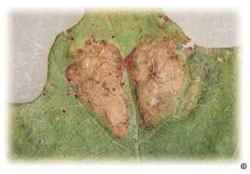Oak Leaf Blisters

image planttalk.org
Oak leaf blisters are a symptom of a fungal infection in oak trees known as Taphrina caerulescens. All oaks can suffer from this infection, although black and red oaks are more likely to succumb to it than white oaks. Here’s a look at all you need to know about the blisters and how to care for your oaks.
The Appearance of Oak Leaf Blisters
The blisters appear usually in the early summer. You’ll notice small, yellow, circular areas that are slightly raised in the leaves. Over time, the blisters will scatter and appear with gray depressions. They get a reddish-brown coloring, keeping the yellow around the edges. However, eventually they will turn completely brown.
In some cases, the leaves can start curling. This happens when several blisters appear in the same leaf.
Due to the side effects to the leaves, the trees will lose their leaves early in the fall. The fungal infection will remain within the tree, usually in the crevices in the bark.
Initially an Overlooked Infection
You may not even notice that there are blisters at first. They are only up to an inch in diameter and don’t usually affect a large area at once. It’s only when a number of leaves are infected on a large scale that people begin to notice.
Over the years, the trees can become weakened due to the fungal disease. This makes them more likely to succumb to other diseases and organisms.
Fungicides Can Be Used
One of the best ways to control the fungal infection is to use a fungicide. This is popular when the infection spreads considerably and looks unsightly. The fungicide needs to be applied before the leaves start to appear on the tree. Once the leaves appear, the infection and the symptoms will already have started to develop.
It’s also possible to control through natural means. Pruning and watering are popular options, as well as reducing insect infestations.

